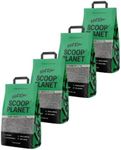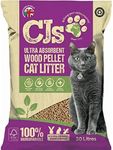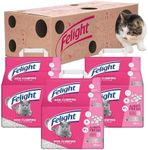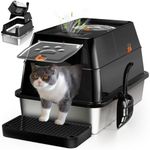Buying Guide for the Best Non Tracking Cat Litter
Choosing the right non-tracking cat litter is essential for maintaining a clean and comfortable environment for both you and your feline friend. Non-tracking cat litter is designed to minimize the amount of litter that sticks to your cat's paws and gets scattered around your home. When selecting the best non-tracking cat litter, consider factors such as material, dust levels, odor control, and clumping ability. Understanding these key specifications will help you make an informed decision that suits your cat's needs and your household preferences.MaterialThe material of the cat litter is crucial as it affects tracking, odor control, and dust levels. Common materials include clay, silica gel, and natural options like corn, wheat, or pine. Clay is popular for its clumping ability but can be dusty. Silica gel is low-dust and good for odor control but may not clump. Natural materials are eco-friendly and often low-dust but may not control odor as well. Choose a material based on your cat's preferences and any allergies or sensitivities they may have.
Dust LevelsDust levels in cat litter can impact both your cat's health and the cleanliness of your home. High-dust litters can cause respiratory issues for both cats and humans, especially if anyone in the household has allergies. Low-dust litters are preferable for a cleaner environment and healthier air quality. If your cat or anyone in your home is sensitive to dust, opt for a low-dust or dust-free litter to minimize irritation.
Odor ControlOdor control is important for maintaining a pleasant-smelling home. Some litters have added fragrances to mask odors, while others use natural ingredients to neutralize smells. If you or your cat are sensitive to fragrances, choose a litter with natural odor control. Consider how often you can clean the litter box; if it's less frequent, a litter with strong odor control might be necessary to keep smells at bay.
Clumping AbilityClumping ability refers to how well the litter forms solid clumps when wet, making it easier to scoop and clean. Clumping litters are generally preferred for their ease of maintenance, as they allow for quick removal of waste. Non-clumping litters may require more frequent complete changes. If you prefer a litter that is easy to clean and maintain, opt for a clumping variety. However, if your cat has specific preferences or health issues, a non-clumping option might be more suitable.
TrackingTracking refers to how much litter is carried out of the box on your cat's paws. Non-tracking litters are designed to minimize this issue, keeping your floors cleaner. The texture and weight of the litter can affect tracking; heavier and larger granules tend to track less. If you want to reduce the amount of litter scattered around your home, look for litters specifically labeled as non-tracking or low-tracking.

















